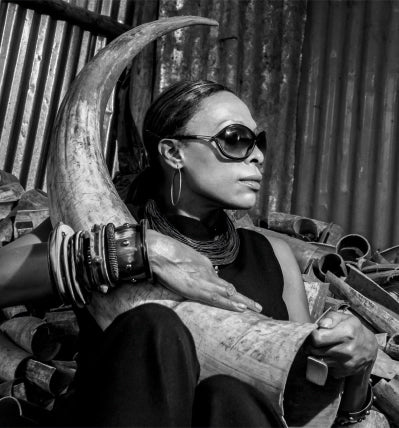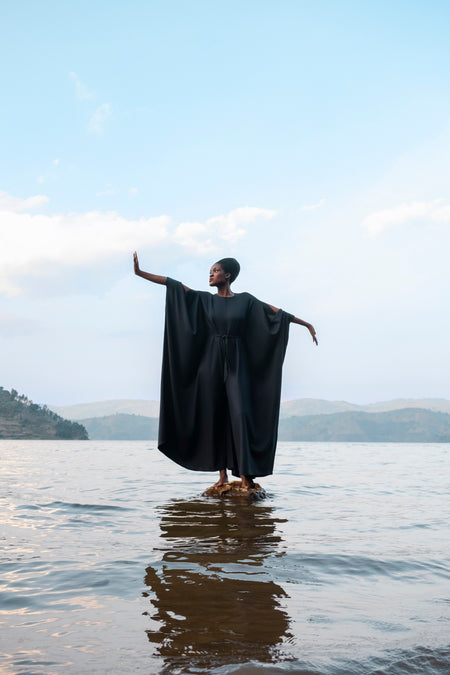Adele Dejak: Born from the language of jewellery
“I am so lucky. I wake up each morning and can look out at Mount Kenya from the comfort of my bed,” says Adele Dejak, on the phone from her idyllic home in the valley at the base of this natural wonder. “It’s magical here, the opposite of city life,” she continues. “I like the colder climate and the people are simple and humble and extremely grateful for the little things in life, like rain.” It’s her travels and experiences across Africa that have long inspired this renowned jewellery and accessories designer, whose statement pieces dare you to wear them with pride. “When I first start working on a collection, I look at what’s around me in my environment, and my books and art, and produce ideas. It’s about bold simplicity,” she adds.
Dejak’s creative journey began early on. Born in Kano, Nigeria, she went to school and university in the UK and although her degree was in law, the art of adornment always fascinated her.
“When she died, my family found a trunk in her hut where she’d kept all the gifts of necklaces I’d given her that she wore for special occasions. It makes me so happy to remember her, so I’ve recreated her hut next to my home. It’s just a pity that she didn’t live to see me pursue this path in the end.”
Never destined to go into law, she retrained in typographic design at the London College of Communication in the UK, before relocating to Rome where she worked in magazines, and then onto Nairobi and Uganda, finally returning to Nairobi in 2005. At first it was a culture shock. “Because I have a West African upbringing, I assumed Kenya would be similar. Nigerians love joking, they’re very upfront and love spicy food. Here, it was the opposite. It’s much calmer and no one is bragging. But I love it now and I’ve made it my home.”
As she settled into her new pace of life, Dejak started to make jewellery for herself to wear and soon enough, heads turned. “In Rome I’d go to markets at the weekend, buy stones and assemble them. And when we came to Nairobi, the first place I went to was the Maasai market and totally decked myself out in Maasai regalia, like most people do when they arrive in Kenya. I’d dismantle a piece of jewellery and make something else for my own wardrobe. At a dinner one night, someone asked me to make 20 bracelets for an event and within a month, the brand had begun.”
Her early collections incorporated semi-precious gems into more classic designs, but her aesthetic and use of materials steadily evolved into something distinctly her own.

Dejak’s creative journey began early on. Born in Kano, Nigeria, she went to school and university in the UK and although her degree was in law, the art of adornment always fascinated her.
“I adored my grandmother and we only ever communicated in the language of jewellery because she spoke Tiv, and I spoke Hausa or English. So, we talked through beads,” Dejak recalls.
“When she died, my family found a trunk in her hut where she’d kept all the gifts of necklaces I’d given her that she wore for special occasions. It makes me so happy to remember her, so I’ve recreated her hut next to my home. It’s just a pity that she didn’t live to see me pursue this path in the end.”
Never destined to go into law, she retrained in typographic design at the London College of Communication in the UK, before relocating to Rome where she worked in magazines, and then onto Nairobi and Uganda, finally returning to Nairobi in 2005. At first it was a culture shock. “Because I have a West African upbringing, I assumed Kenya would be similar. Nigerians love joking, they’re very upfront and love spicy food. Here, it was the opposite. It’s much calmer and no one is bragging. But I love it now and I’ve made it my home.”
As she settled into her new pace of life, Dejak started to make jewellery for herself to wear and soon enough, heads turned. “In Rome I’d go to markets at the weekend, buy stones and assemble them. And when we came to Nairobi, the first place I went to was the Maasai market and totally decked myself out in Maasai regalia, like most people do when they arrive in Kenya. I’d dismantle a piece of jewellery and make something else for my own wardrobe. At a dinner one night, someone asked me to make 20 bracelets for an event and within a month, the brand had begun.”
Her early collections incorporated semi-precious gems into more classic designs, but her aesthetic and use of materials steadily evolved into something distinctly her own.


Recycled brass and Ankole cow horn is crafted into show-stopping yet ultimately wearable pieces that make your outfit and lift your mood. “I’m not doing this to be fashionable or cool. My objective is to empower women by feeling good in my jewellery,” she asserts.
The brand has gone on to be stocked and shown internationally, and she’s previously paired up with a variety of collaborators including Salvatore Ferragamo and Nigerian product design firm Afro Minima. And now she’s teamed with Asantii for a capsule jewellery collection. Each piece is a take on one of Dejak’s signature designs, such as the Afro Queen pendant and Mbadon ear pin, their organic shapes and raw finishes epitomising her confident approach to the artform.
“Each design is unique and isn’t something that will languish at the bottom of your jewellery box. These are everyday pieces that the wearer can interpret in their own way.”
This capsule is also a testament to the talents of her team in Nairobi. Dejak employs a growing group of eight artisans alongside two tailors (currently making her bag designs from Malian mud cloth), all headed up by her master craftsman and educator, Musa. “Another reason why I love Kenya is that the people are really smart. The skills you’d go to college for months to learn in the UK, my team pick up in a week, and I’m not exaggerating,” she says. “I do the drawings and mock ups in plasticine or cardboard cut outs and give those to my team. They do the prototypes and by the second round, it’s done. Together we have created what I envisioned.”
Currently nestling on her moodboard are examples of Dogon art, the buildings of Zaha Hadid and the paintings of Alberto Burri. Where these inspirations will lead, Dejak does not know yet (or isn’t telling), but her loyal customers can be sure of greatness. “I want to go into gold-plated brass, that’s the next step.” Meanwhile, the designer takes time to focus on her own doorstep, where she supports the Mount Kenya Trust’s efforts to tackle deforestation. “I am obsessed with trees and obsessed with nature. Farmers are struggling here with drought and it’s worrying. So as a Christian, I do what I can do, on a small scale, wherever I can,” she says modestly.
Because without that, there are no more majestic view, which help her to think if not big, then better. “Like most designers, the limitations are money and time, but I would say that I’m slowly getting to where I want to be. When I reach a stumbling block, I just keep doing what I’m doing, and then when it’s time, I come out with a bang.”
Words by Helen Jennings





